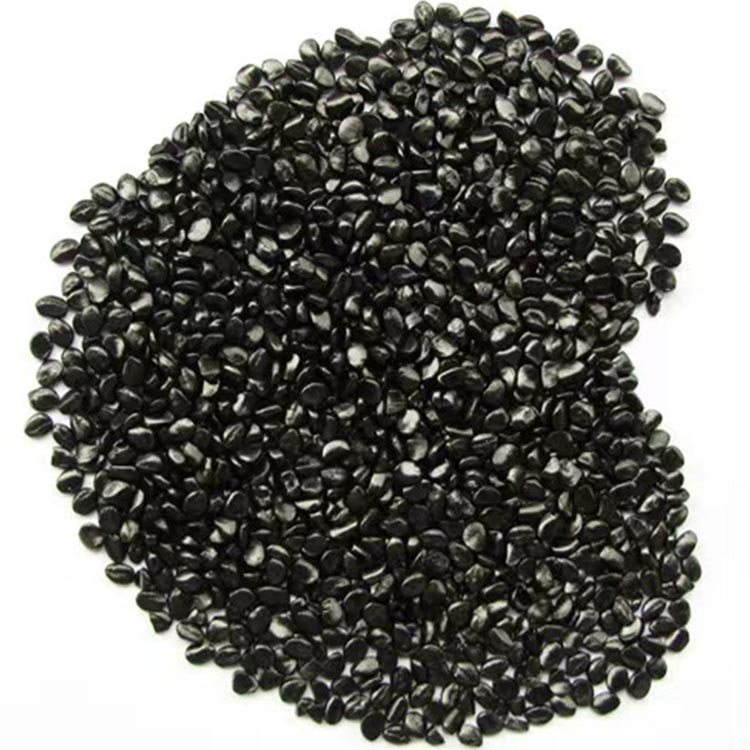塑料黑色母粒
塑料黑色母粒的生产工艺主要分为三个步骤:颜色分散、热加工和制粒。下面我们将分别介绍这三个步骤的工艺流程。
颜色分散是将各种颜色颜料分散到树脂基材中的过程。它是将颜料先在较低的温度下与树脂材料混合,并在高速搅拌下达到良好的颜色分散度。通常,颜料的用量为5%-30%不等。
热加工是将颜色分散后的原料在高温高压下进行塑化过程,使其达到可挤出的状态。在这个步骤中,原料需要经过一段时间的高温处理,以使颜料在熔融树脂熔融期间充分分散,从而获得优秀的黑色母粒。
制粒是将塑化后的原料通过磨粉机或切割机进行切割,得到相对均匀的颗粒,成为黑色母粒。粒径大小是一个非常重要的指标,通常为2.5mm~3.0mm,在不同的塑料制品加工过程中,颗粒的大小会产生不同的影响。
塑料黑色母粒是一种常用于塑料制品生产中的颜料。它的主要成分是黑色颜料和树脂基材,可以用于塑料中添加颜色并提高其光泽、耐磨性和耐光性。
一、塑料黑色母粒的用途
塑料黑色母粒的主要用途是塑料制品中添加颜色。在实际生产中,塑料黑色母粒可用于各种注塑、挤出、吹塑和压延等工艺中,制造黑色塑料制品。常见的黑色塑料制品有黑色桶、黑色管道、黑色家具、黑色汽车配件、黑色手机壳等等。

二、塑料黑色母粒的生产工艺
塑料黑色母粒的生产工艺主要分为三个步骤:颜色分散、热加工和制粒。下面我们将分别介绍这三个步骤的工艺流程。
颜色分散是将各种颜色颜料分散到树脂基材中的过程。它是将颜料先在较低的温度下与树脂材料混合,并在高速搅拌下达到良好的颜色分散度。通常,颜料的用量为5%-30%不等。
热加工是将颜色分散后的原料在高温高压下进行塑化过程,使其达到可挤出的状态。在这个步骤中,原料需要经过一段时间的高温处理,以使颜料在熔融树脂熔融期间充分分散,从而获得优秀的黑色母粒。
制粒是将塑化后的原料通过磨粉机或切割机进行切割,得到相对均匀的颗粒,成为黑色母粒。粒径大小是一个非常重要的指标,通常为2.5mm~3.0mm,在不同的塑料制品加工过程中,颗粒的大小会产生不同的影响。
三、塑料黑色母粒的性能
良好的着色性能
塑料黑色母粒具有良好的着色性能,其添加量可控制在5%~30%之间,可以满足大多数黑色塑料制品的生产需求。
良好的光泽性能
黑色母粒的光泽度高,黑色塑料制品通常具有较高的表面光泽度。
良好的耐磨性能
黑色母粒中的颜料有很高的耐磨性能,所以黑色塑料制品具有较好的耐磨性能,不易划伤和磨损。
良好的耐光性能
黑色母粒具有良好的耐光性能,可防止黑色塑料制品在阳光下褪色和变黄。
Plastic black masterbatch is a pigment commonly used in the production of plastic products. Its main components are black pigment and resin substrate, which can be used in plastics to add color and improve its luster, abrasion resistance and light resistance.
First, the use of plastic black masterbatch
The main use of plastic black masterbatch is to add color in plastic products. In actual production, plastic black masterbatch can be used in a variety of injection molding, extrusion, blow molding and calendering processes, manufacturing black plastic products. Common black plastic products are black barrels, black pipes, black furniture, black auto parts, black cell phone cases and so on.
Plastic black masterbatch
Second, the production process of plastic black masterbatch
The production process of black masterbatches is mainly divided into three steps: color dispersion, thermal processing and granulation. Below we will introduce the process flow of these three steps.
Color dispersion is the process of dispersing various color pigments into the resin substrate. It involves mixing the pigments with the resin material at a lower temperature first, and achieving a good color dispersion under high-speed mixing. Usually, the amount of pigment varies from 5% to 30%.
Thermal processing is the process of plasticizing the raw material after color dispersion under high temperature and high pressure to make it reach the extrudable state. In this step, the raw material needs to be processed at high temperature for a period of time in order to fully disperse the pigment during the melting of the molten resin, so as to obtain excellent black color masterbatch.
Pelleting is the process of cutting the plasticized raw material through a mill or cutter to obtain relatively homogeneous particles that become the black masterbatch. The size of the granules is a very important index, usually 2.5mm~3.0mm, and the size of the granules will have different effects in the processing of different plastic products.
Third, the performance of plastic black masterbatches
Good coloring performance
Plastic black masterbatch has good coloring performance, and its additive amount can be controlled between 5% and 30%, which can meet the production needs of most black plastic products.
Good gloss performance
Black masterbatch has high gloss, black plastic products usually have high surface gloss.
Good abrasion resistance
The pigments in black masterbatches have high abrasion resistance, so the black plastic products have good abrasion resistance and are not easy to be scratched and abraded.
Good light resistance
Black masterbatches have good light resistance, which can prevent black plastic products from fading and yellowing under sunlight.









